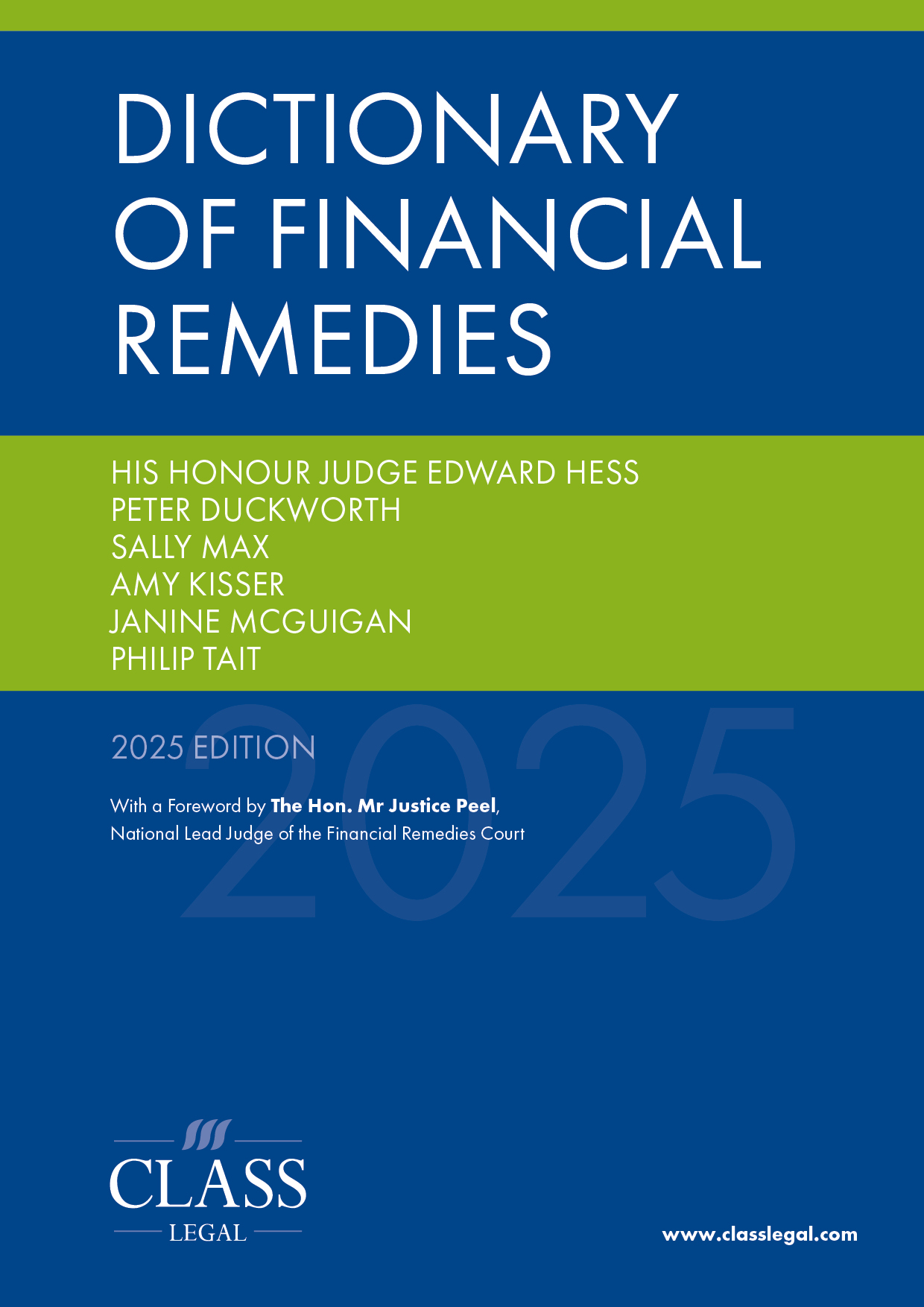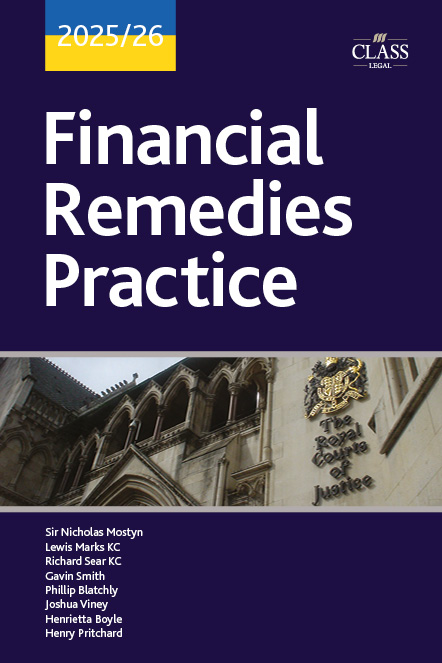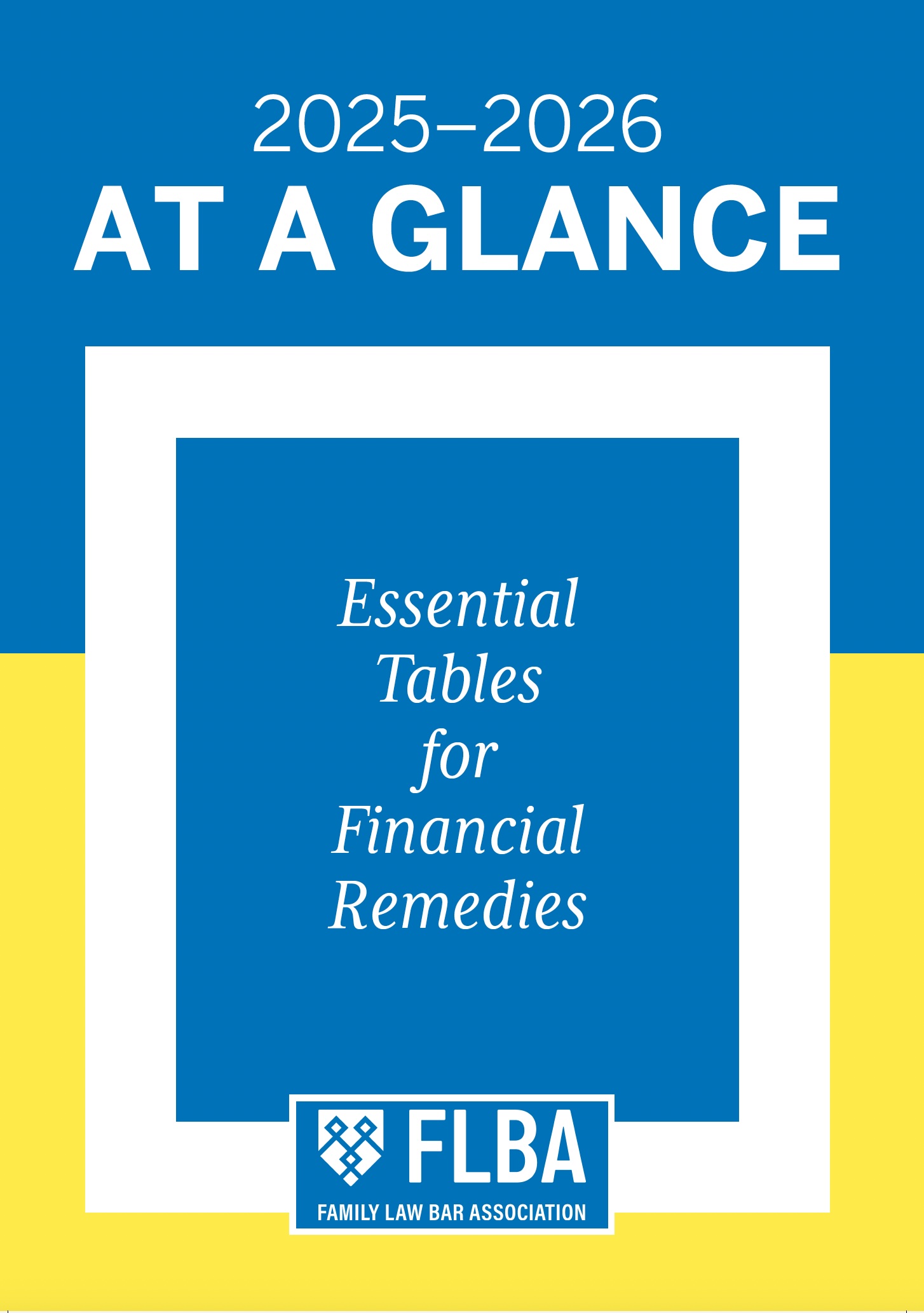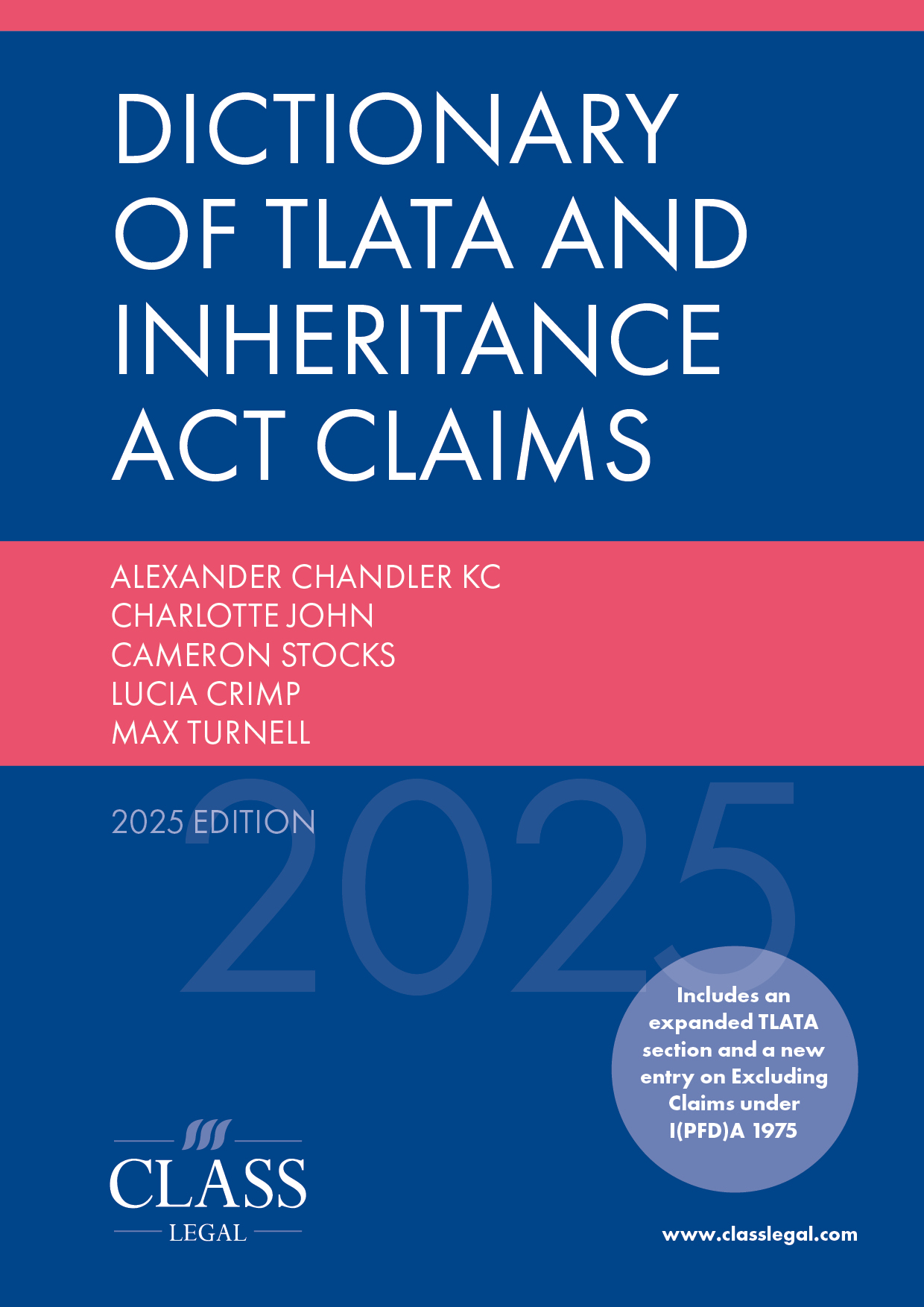
‘Feral, Unprincipled and Unnecessarily Expensive’ – A Guide to Intervenor Claims
Published: 30/06/2025 06:00

Introduction
Intervenor claims take us – family lawyers – out of our comfort zone.
As financial remedy (FR) specialists we are used to dealing with discretion and grey areas: the assessment of housing and income need, where to draw the line between marital and non-marital assets, how to reflect pre-marital contributions. The proverbial bad day in court may produce an outcome at the bottom end of a bracket but it generally won’t mean the entire claim is dismissed. And when things go really bad (or well) at court, the judge may come to a party’s rescue: the overarching objective, after all, is a fair outcome, and the court’s approach is not adversarial but ‘quasi-inquisitorial’, whereby, as with care proceedings, the court is not ‘… confined within the tramlines of adversarial pleadings’ (Baker LJ in Re HW [2023] EWCA Civ 149 at [37]), and the judge has a duty to independently ‘… investigate issues which he considers relevant to outcome even if not advanced by either party’ (Thorpe LJ in Parra v Parra [2002] EWCA Civ 1886 at [22]). Normally, each party will pay their own costs (FPR 29.3(5)).
By contrast, intervenor (IV) claims tend to be binary: the IV either can or cannot establish his interest in property. Where this involves a dispute of recollection but little documentary evidence, credibility can be pivotal, so a bad day in court – a witness who fails to come up to proof or whose reliability is undermined in cross examination – can mean the case is won or lost. Costs will generally follow the event – and IV cases can be very expensive indeed.
So, while IV claims involve challenging and interesting work, compared to the usual horse trading at an FDR, they are not for the faint hearted. They can go wrong, and spectacularly so.
How wrong can a case go? Uddin v Uddin and Begum
The title of this article comes from HHJ Wildblood KC’s judgment in Uddin v Uddin and Begum & Ors [2022] EWFC 75. Like many good judgments, its essence is contained in the very first line:
‘[1] These are feral, unprincipled and unnecessarily expensive financial remedy proceedings.’
Uddin is a lengthy judgment (200 paragraphs), but its essential facts can be stated briefly:
- H issued Form A in 2018. W issued a civil claim seeking declarations that H held beneficial interest in properties held by third parties, and a controlling interest in an Indian restaurant in Somerset (the New Chandni Restaurant, Burnham-on-Sea, for those who take an interest in these sorts of details).
- Anyone who has appeared in a combined Schedule 1 and TLATA claim will know how difficult it is to case manage a civil alongside a family claim, and so it proved in Uddin, which was initially allocated to the Business and Property Court, then to the County Court, and finally to the Family Court at Bristol where it was allocated to HHJ Wildblood KC.
- The litigation had by that stage accumulated seven respondents in addition to the husband and wife: including the legal owners and occupants of the two properties, in relation to the restaurant, a company and main its shareholder.
The judgment in Uddin contains the following pithy overview of the legal wranglings:
‘[7] … Before descending into the mass of detail in this case, I want to give an overview. Apart from the trust claims (which, as I explain, are meritless and misconceived), this case should have been simple. …
[13] … I wish to emphasise that I have given repeated warnings, both during this hearing and in the pre-trial review in April that the pursuit of the trust claims could leave at least one party “wiped out” by the costs. Further, because of the arguments that were advanced at the hearing in April, that hearing should have given the wife cause to reflect very carefully about the trust case that she was arguing. The arguments that I have heard at this hearing, even in the closing speech on her behalf, showed that no heed had been taken to my warnings or to the obvious weaknesses in her trust case.’
It proceeds to get steadily worse for the applicant – and here we are only a tenth of the way into the judgment:
‘[24] (ii) … The case has been in and out of court due to procedural infighting. In relation to the trust claims the wife has never set out in any meaningful sense how it is that she seeks to justify the claims or the shares that she seeks in the two relevant properties (High St and 4 Morland Rd); for instance, the case of Laskar v Laskar [2008] EWCA Civ 347 (to which I refer later) has simply been ignored by her.
(iii) The trust claims are hopeless. It is simply not necessary to descend into any form of lengthy analysis of the equitable principles of resulting and constructive trusts. In relation to both properties in issue (50–52 High St and 4 Morland Rd) there is no evidence that the husband made any direct financial contribution to the purchase of either property or to mortgage payments. There is no evidence of a common intention (express, implied or imputed) that he would have a share in them – quite the reverse, since it was the very clear intention that the legal title holders would be the beneficial owners of the two properties. From the start, the trust claims as presented bore the evidential difficulty of the wife (an outsider) seeking to establish that the holders of the legal title and the husband shared beneficial interests in properties that both title holders and the husband denied; that evidential reality has not been reflected in anything that I have heard on her behalf.’
This downward trajectory concludes in a brutal denouement for W’s advisers:
‘[146] Regrettably, I think that it is extremely disappointing that the points that were made so clearly by the Respondent parties at the hearing in April about the applicable trust principles were not absorbed more carefully on behalf of the wife. The above passage shows a confusion of analysis between the law relating to constructive trusts and that relating to resulting trusts. The very short passage, cited as coming from Jones v Kernott (which it does not), is not a complete analysis of the law. No further arguments about the applicable law were advanced on behalf of the claimant. I have no bundle of authorities. No mention was made by the wife’s counsel of Laskar v Laskar [2008] EWCA Civ 347 or Marr v Collie [2017] UKPC 17. No explanation has ever been given as to why the wife asserts the beneficial interests that she does. …
[152] In my opinion the wife’s trust claims have been unprincipled and have stuck rigidly to the contentions made at the outset of these proceedings without there being any sufficient analysis of the evidence as it is has come in or the law applicable to it. …
[200] … these proceedings are a disgraceful example of how financial remedy proceedings should not be conducted. The wife may wish to take advice about why her case was presented in this way and why so much expense has been incurred.’
While Uddin was a very unusual (but compellingly readable) case, it is far from unique when it comes to reported case of IV claims going spectacularly wrong.
It is often overlooked that in TL v ML [2005] EWHC 2860 (Fam), perhaps the most cited of first instance FR decisions, the parties had incurred a total of £474,000 in costs in relation to assets worth £560,000. In KSO v MJO [2008] EWHC 3031 (Fam) the case imploded under the weight of the costs incurred in interlocutory squabbling: Munby J (as he then was) commented:
‘[80] The picture is deeply dispiriting. And it is not as if it is only the adults who suffer from the consequences of such folly. The luckless children do as well. The present case is a sobering, and for me deeply saddening, example. If, instead of spending – squandering – over £430,000 in costs, the wife and the husband had been able to resolve their differences at a more modest and, dare I say it, more seemly level of costs, there might very well have been enough left in the matrimonial “pot” to house the wife and children and to enable the children to remain at their school, whilst still leaving something more than a mere consolation prize over for the husband. As it is, it is hard to see much being left from the wreck, not least after the trustee in bankruptcy has had his costs, expenses and remuneration. It is difficult not to be reminded at this point of Jarndyce v Jarndyce (see the Appendix). And the wife and the husband – and for this purpose I refer to them as the mother and the father, for that is what they are – are faced now with the wretched and thankless task of trying to explain to their daughters how it has all come to this.’
A number of lessons can be learned from these sad cases:
- IV claims can be legally and procedurally complicated.
- The outcome turns not on broad discretion and the court’s objective view of what might be fair, but whether the claimant (so to speak) has proven the various required elements of his case, to the civil standard. IV claims can be very expensive indeed, significantly more so than the originating FR proceedings between husband and wife.
A good rule of thumb for a family lawyer in an IV case, and also in TLATA, is given the complexities of the law (‘the witches brew’ per Carnwath LJ1), there’s a sporting chance that someone in the case – a barrister, solicitor or judge – will get the applicable law wrong. So, if it isn’t your opponents or the judge, it may be worth double checking your skeleton before sending it off. And in fairness to the judiciary, one of the quirks of this area of law is that the judge who hears the IV claim (which may turn on issues of constructive trust, etc) may have no jurisdiction to deal with a freestanding TLATA claim.2
So, with apologies to those of who are already well versed in the lore/law of IV claims, let’s go back to basics.
What is an IV claim?
Financial remedy claims normally involve two parties: husband and wife, or in same sex cases, applicant and respondent.
Pursuant to FPR 9.26B, the Family Court can join a third party (‘intervenor’) either: (a) where it is ‘desirable’ to do so that the court can resolve all the matters in dispute; or (b) there is an issue involving the new party and an existing party which is connected to the matters in dispute, or desirable to join to resolve that issue.
The seminal point to note is that, where an IV is joined for the determination of a disputed preliminary issue, such as who is the beneficial owner of property/shares, etc the FR court resolves those issues not on the basis of the discretionary principles that only arise between divorcing spouses (i.e. MCA 1973) but on the basis of the general law that applies between co-owners, typically involving a consideration of the principles of constructive trust, proprietary estoppel or resulting trust.
This was put most clearly by Nicholas Mostyn QC (as he then was, sitting as a DHCJ) in TL v ML [2005] EWHC 2860 (Fam):
‘[34] It is to be emphasised, however, that the task of the judge determining a dispute as to ownership between a spouse and a third party is, of course, completely different in nature from the familiar discretionary exercise between spouses. A dispute with a third party must be approached on exactly the same legal basis as if it were being determined in the Chancery Division.’
This is why IV claims can be such a culture shock for family lawyers. We work in an increasingly siloed legal world where FR practitioners normally steer clear of Chancery work (and vice versa), and where FR judges habitually make orders that depart from the parties’ proprietary interests at common law. I once attended a Chancery Bar Association conference where the speaker was attempting to explain what an FDR was: the delegates’ response was a mixture of bafflement and confusion.
As FR practitioners we don’t normally have to concern ourselves with issues of beneficial ownership. With apologies for quoting myself, I attempted to summarise the position in DDR v BRD [2024] EWFC 278:
‘[1] The family court does not normally have to resolve issues of beneficial ownership between divorcing spouses.
[2] In most financial remedy claims, a declaration as to the parties’ equitable interests would be: “… of very little value … it simply adds confusion and trouble and achieves nothing” (Fielding v Fielding [1977] 1 WLR 1146, per Ormrod LJ). A claim for financial remedies should normally “… be determined within the four corners of the Matrimonial Causes Act and on the application of the statutory criteria there set out”, not by reference to equitable interest (Prazic v Prazic [2006] EWCA Civ 497, per Thorpe LJ at [25])
[3] In Tsvetkov v Khayrova [2023] EWFC 130, Peel J summarised the position as follows:
“… ordinarily, in financial remedy proceedings, it matters little as between a husband and wife in whose name an asset is beneficially held. The court has wide dispositive powers to adjust ownership as part of its overall determination of the fair outcome. An exception to this general proposition is where a third party [IV] asserts a beneficial interest …”’
When do IV claims arise?
Disputes over beneficial ownership
The most common scenario for the joinder of an IV is probably where there is dispute about the beneficial ownership of real property. A husband might assert in Form E that while he is the legal owner of a property, he holds it for his parents/uncle/brother, etc because they were too old/didn’t have enough income to obtain a mortgage, so the family agreement is that it would be put in H’s name. The wife in turn may say, that’s the first I’ve heard of it, my in-laws are thick as thieves, and they said exactly the same when my brother-in-law went through his horrendous divorce.
This creates the classic scenario for an IV claim, whereby the First Appointment judge will be told (typically by H’s representative) that H’s family members want to be joined, so as to be heard in relation to the preliminary issue of their alleged beneficial ownership of property.
Other situations
The power to join a third party is not restricted to claims for beneficial ownership between family members. It can arise in other situations, such as: (a) where a spouse is declared bankrupt, an issue arises between the other spouse and the trustee in bankruptcy, e.g. DDR v BDR (Financial Remedies, Beneficial Ownership and Insolvency) [2024] EWFC 278; (b) where a third party seeks to recover monies that are owed by a spouse, e.g. Bogolyubova v Bogolyubov and Privatbank [2022] EWFC 199; or (c) in more exceptional situations, e.g. the extraordinary facts of the litigation funder case of Simon v Simon and Integro Ltd [2024] EWFC 160.
Why do we have IV cases?
Essentially, the point of an IV claim is to determine which assets come within the court’s reach: if the beneficial owners of a property are third parties, then obviously it would not come within the ‘marital pot’ that falls to be re-distributed in the main FR proceedings. The late lamented Val le Grice QC put it best when he submitted: ‘… the size of the cake should be ascertained before the knife is applied to it’ Gourisaria v Gourisaria [2010] EWCA Civ 1019 per Hughes LJ at [12].
The legal font of the IV claim is the Court of Appeal’s decision in Tebbutt v Haynes [1981] 2 All ER 238, which, frustratingly, has not been given a neutral citation or published online on BAILII or the National Archives. Tebbutt v Haynes was a case about issue estoppel. In the original ancillary relief proceedings, the court joined H’s mother and aunt before making declarations as to beneficial ownership. Aunt proceeded to issue a fresh set of proceedings in the Chancery Division. Could she do this? No, held the Court of Appeal, obviously she couldn’t.
- The court dealing with financial remedies (then ‘ancillary relief’) had to be able to establish what property came within its reach:
‘It is fundamental to the s 24 [MCA] jurisdiction that the judge should know over what property he is entitled to exercise his discretion. If there is a dispute between a respondent spouse and a third party as to the ownership of a particular item of property which stands in the respondent spouse’s name, that dispute must be resolved before the judge can make an effective final order under s 24. There are only two ways of resolving such a dispute. Either the Family Division proceedings must be adjourned pending the trial of the claim in other proceedings, or the dispute must be decided in the s 24 proceedings by allowing the third party to intervene’
- Where the court had joined third parties, inquired into those disputed issues and reached findings of fact, those findings were conclusive – in other words, aunt could not just re-start the litigation in another Division:
‘It seems to me that, under s 24 of the 1973 Act, if an intervenor comes in making a claim for the property, then it is within the jurisdiction of the judge to decide on the validity of the intervenor’s claim. The judge ought to decide what are the rights and interests of all the parties, not only of the intervenor, but of the husband and wife respectively in the property. He can only make an order for the transfer, to the wife, of property which is the husband’s property. He cannot make an order for the transfer to the wife of someone else’s interest. So, in order to make an order under s 24, it must be within the jurisdiction of the judge to determine what are the various rights and interests in the property not only of husband and wife but also of any other persons who claim an interest.’ (per Denning MR at 242)
The Court of Appeal contemplated two alternatives: (1) join the third party so that the (family) court can resolve the disputed issues of beneficial ownership (etc) preliminary to resolving the financial claims of the main parties (H and W); or (2) stay the FR proceedings pending the conclusion of ongoing proceedings which would determine those disputed issues.
Subsequent authority has established that the first alternative (joining a third party IV) is normally preferable: e.g. Baker v Rowe [2009] EWCA Civ 1162, in which Wilson LJ (as he then was) observed that it was normally ‘convenient’ for a third party to intervene as a party in the ancillary relief proceedings:
‘[23] … Ever since the decision of this court in Tebbutt v Haynes [1981] 2 All ER 238, it has been recognised as convenient that a third person who asserts a beneficial interest in property which is the subject of an application for ancillary relief following divorce should either be permitted as an intervenor, or ordered as a further respondent, to make his assertion within, and thus as a party to, the application, rather than that the existence or otherwise of his alleged interest be determined in separate proceedings in a separate court at a separate time, with the consequential risk of inconsistent decisions. It would be highly unfortunate, as well as unprincipled, if such a person, when joined as an intervenor or as a respondent only for convenience, were to find that, even were his assertion successful, a general rule against making any order for costs inter partes would operate against him.’
Joinder
An important caveat is that for the determination to be effective and binding, the third party IV must be joined as a party, in Gourisaria v Gourisaria [2010] EWCA Civ 1019, per Hughes LJ (as he then was):
‘[19] I have no doubt that, ordinarily, intervention, if it is accepted, is much the best means of achieving a decision on all material matters in a manner which binds not only the spouses but also any third party …
[20] I also agree that a simple invitation to intervene is not by itself sufficient to produce an order which binds a third party who does not accept the invitation. That was the point which troubled Munby LJ. For my part, I respectfully agree with him and I particularly agree that neither TL v ML or Rossi v Rossi or any of the other cases go anywhere near suggesting otherwise. On the other hand, of course if an invitation to intervene is given and not taken up, that is undoubtedly something that the English court can and should take into account in deciding whether to proceed or not. There was in this case a plain means available to the brother to make his voice heard on the issue before the court, which was well advanced in considering the case. …
[23] Accepting as I do the general proposition that it is highly desirable that issues between a third party and spouses should be resolved at the same time as the issue between the spouses, there will be some cases in which it simply cannot be done and there will be others where it could be done only at the cost of a price which ought not to have to be paid.
[24] In all those cases, indeed in every case, the question is a case management one, it is a case specific one and it calls for the exercise of the judge’s discretion.’
As to which party (H or W) is under a duty to ensure a relevant third party is joined, see Fisher Meredith LLP v JH [2012] EWHC 408 (Fam): the duty falls upon the existing party who supports the IV’s claim (see Mostyn J, [42]–[44] and [49]).
Second alternative: staying the claim
As with all good things in life and law, there are exceptions, where FR proceedings are better stayed, e.g. where the disputed issue involves technical issues that might be more suitable to be heard at a specialist court, as recognised recently by the Court of Appeal in Bogolyubova v Bogolyubov and Privatbank [2023] EWCA Civ 547, where King LJ commented that: ‘[48] The dangers of second guessing the outcome of substantial future third party litigation was highlighted in George v George [2003] EWCA Civ 202’.
Where do IV claims arise?
An IV claim can arise anywhere. However, anecdotally, and for what it’s worth, the majority of IV cases I’ve dealt with in practice have involved families who originate from the Indian sub-continent. I’m not qualified to express an opinion as to why so many IV cases involve Asian families, but I suspect a number of factors are involved: the importance of wider family ties beyond the nuclear family, the tradition of generous family support of newlyweds, the expectation in some families that newlyweds should live with the husband’s family.3
How does (or should) an IV claim arise?
FPR 9.26B mirrors its civil counterpart (CPR 19.2), providing that a party may be joined where:
‘(a) it is desirable to add the new party so that the court can resolve all the matters in dispute … or
(b) there is an issue involving the new party and an existing party which is connected to the matters in dispute … and it is desirable to add the new party …;’
As to the interpretation of this rule, in DR v GR & Ors [2013] EWHC 1196 (Fam), Mostyn J explained at [35] that:
‘(v) Under the first limb it must be clearly shown that an existing matter in dispute between the parties cannot be effectually and validly resolved without the joinder of the proposed new party.
(vi) Under the second limb it must be shown that there is a separate dispute between a party and the proposed new party and that it is desirable to hear the matters together. The question of whether it is desirable to hear the matters together extends to the commonality of evidence as well as the saving of costs.’
The procedural rules about joining an IV
The following provisions are admittedly more honoured in the breach and are subject to the exception that the court can join a party of its own motion (FPR 9.26B(4)).
FPR 9.26B(5) confirms that the Part 18 procedure should apply whereby a proposed IV should:
(a) issue an application notice (FPR 18.4), stating what order is sought and why the application is being made, attaching a draft order (r 18.7);
(b) support the application with evidence setting out the proposed IV’s interest or connection with the proceedings (FPR 9.26B(5));
(c) make the application on notice, served with at least seven days’ notice (FPR 18.8(b)(i)).4
Court’s discretion whether to join
The court accordingly exercises a discretion whether or not to join. No third party is entitled as of right to become a party in an FR case, causing untold delay and additional expenses (aka creating leverage for one spouse to wrest a better settlement). Whether it will be desirable to join a third party IV will depend on the facts. This point cannot be too strongly emphasised. In Behbehani v Behbehani [2019] EWCA Civ 2301, the Court of Appeal underlined the following:
‘[69] … It all depends on the circumstances … It would be wholly disproportionate to insist that, even where the wife is not seeking the transfer of the assets, all such persons should be joined to the proceedings and the issue of ownership determined before any financial remedies order can be made. There may be cases where joinder is appropriate in those circumstances, but it should certainly not be the rule.’
In some cases, the case for joining a third party may be overwhelmingly strong: the third party may have issued an application, set out a strong prima facie case, the issue at stake may be so pivotal to the FR proceedings that the case is going to be stuck until this issue (e.g. beneficial ownership) is resolved.
In others, however, the court might refuse a request to join an IV, e.g.:
(a) Where the disputed asset is of peripheral importance – e.g. an asset with limited net equity, or an asset which was inherited/non-marital in character.
(b) Where the case can be resolved (or at least, an effective FDR can take place) without needing to go down the line of an active IV claim, e.g. where the issues are narrow, or mainly concern points such as periodical payments.
(c) Where the subject matter of the IV claim can reasonably dealt without joinder, e.g. if a family member seeks to recover a loan, could he attend as a witness, upon the undertaking of one party to repay him back from any award. (NB the court has no power to make orders in favour of third parties: Burton v Burton [1986] 2 FLR 419, Wodehouse v Wodehouse [2018] EWCA Civ 3009).)
(d) Post-FPR 3.4(1A) and Churchill v Merthyr Tydfil CBC [2023] EWCA Civ 1416, there might be a compelling case to stay the proceedings to allow non-court dispute resolution (to include the proposed IV’s claim).
Where an IV is joined, what directions should be made?
TL v ML directions
The starting point has to be TL v ML where the court held as follows:
‘[36] In my opinion, it is essential in every instance where a dispute arises about the ownership of property in ancillary relief proceedings between a spouse and a third party, that the following things should ordinarily happen:
(i) The third party should be joined to the proceedings at the earliest opportunity.
(ii) Directions should be given for the issue to be fully pleaded by points of claim and points of defence;
(iii) Separate witness statements should be directed in relation to the dispute; and
(iv) The dispute should be directed to be heard separately as a preliminary issue before the financial dispute resolution (FDR).’
‘Pleading’
In A v A [2007] EWHC 99 (Fam), Munby J (as he then was) underlined the importance of points of claim and defence in an IV claim:
‘[24] I do, however, entirely share the deputy judge’s view that directions should normally be given for such issues to be properly pleaded by points of claim and points of defence. In the present case the muddle, confusion and ambiguities in the wife’s case would have been more pitilessly exposed, and at a much earlier stage in the proceedings, had the presentation of her case been exposed to the intellectual discipline which is one of the advantages of any system of pleading. Moreover, if the wife had been required to plead her case everyone would have had a much clearer idea, and at a much earlier stage, as to exactly what she was or was not asserting and as to exactly what the husband and the intervenors were or were not saying by way of defence. As it was, matters were wholly unclear even as late as the first day of the final hearing.’
These documents should be directed to be filed sequentially, i.e. IV to file points of claim, then a defence from the party who will likely support the IV (e.g. husband, if claim is made by his family), then a defence from the opposing party.
Disclosure relating to IV claim
When the court at First Appointment wants to give a prospective IV the opportunity to apply to be joined, it should direct one party (typically the spouse who supports the IV’s position) to serve: (a) Form A; (b) the relevant parts of the Form E, etc; and (c) a copy of the relevant part of the First Appointment direction.
In due course, the court may have to provide for disclosure of the documentation relied upon (e.g. declaration of trust, conveyancing file, etc). In some cases, something approximating to standard disclosure might be needed.
However, a point which is often lost in practice is that an IV should not receive wholesale disclosure of the FR papers (or a copy of the bundle). FR proceedings are confidential. Where an IV is joined, he will be entitled to any material relevant to the preliminary issue, but not more generally to the other material (e.g. relating to the parties’ incomes, needs, outgoings, etc). Where the extent of the disclosure is in issue, the court can rule on the extent of disclosure pursuant to its case management powers at FPR Part 4. The point arose most recently in Bogolyubova v Bogolyubov and Privatbank [2022] EWFC 199 where Peel J joined the IV but directed that it:
‘[43] … shall not be entitled to disclosure of any documents within the financial remedy proceedings unless agreed by the parties or ordered by the court. I refuse the specific disclosure sought by PrivatBank which in my view is not necessary, particularly in the light of my primary decision.’
Witness statements
In many IV cases, witness statement can be put off until there has been an FDR. Query if they should they be exchanged simultaneously (as in FR proceedings) or sequentially (as in civil litigation).
Listing hearing before or after FDR
Contrary to the court’s guidance in TL v ML, in many cases an FDR will be directed before the preliminary issue hearing and not vice versa. In a typical medium asset case, it may be preferable to bring all parties (including the IV) to an FDR to see if some sort of agreement is possible, before the costs have escalated all round. This, again, will depend on the facts in the case. Is it going to be possible to resolve the case with the IV issue still at large? Will the FDR judge/private FDR evaluator be able to give a helpful indication in relation to the IV claim?
In Shield v Shield [2013] EWHC 3525 (Fam) Holman J declined to make any general comments about the timing of an FDR but observed that it would have been desirable and proportionate on facts of that case to list an FDR before the preliminary issue hearing:
‘[17] I would have thought that in this case this was a particularly opportune moment to have assembled all concerned (not necessarily the husband himself if he was physically or mentally unfit to attend) in a forum such as an FDR and to have a sustained attempt to see if a resolution to this awful conflict could not be found at a stage when there may be high litigation risk for all concerned.’
At the preliminary issue hearing of Shield v Shield [2014] EWHC 23 (Fam) Nicholas Francis QC (as he then was, sitting as a DHCJ) observed:
‘[108] I note that there was no FDR in relation to the preliminary issue. Whilst, as been made clear in a number of cases, an FDR will not necessarily be appropriate to the resolution of a preliminary issue, I express the view that consideration should at least be given to the possibility of an FDR prior to the hearing of a preliminary issue. It may well have been the case here that the input of an experienced FDR judge might have helped to save this family from the course which it has taken.’
To what extent should the Civil Procedure Rules apply?
Not at all. Per Thorpe LJ in Goldstone v Goldstone [2011] EWCA Civ 39:
‘[39] … Of course the ultimate trial required the family division judge to apply the law of property and the law of sham just as his brother judge would do in the Chancery Division. Careful preparation for that trial was necessary. However, these impeccable directions do not require or permit the import of the CPR. In its essence the claim remains a claim by the wife against the husband. Ultimately it is a claim for discretionary relief. In this, as in many cases, there must be a preliminary issue trial to establish the extent of the assets over which the discretion is ultimately exercised. Here, as in many cases, the preliminary issue trial determines the claims and the rights of third parties. The preliminary issue trial is pendent on the originating application. It has no independent existence.’
However, while the full panoply of civil procedure such as costs budgeting, etc does not apply in an IV claim, the FPR and CPR share several common principles of good case management and the overriding objective. It is suggested that practitioners drafting points of claim and defence in IV claims should be mindful of civil requirement that such documents be ‘concise’ (CPR 16.2).
A brief canter through the law
The critical point, already made, in every IV claim is that the applicable law:
‘[66] … differs importantly from the law to be applied between the wife… [as to the former] the court is not performing a discretionary exercise but is determining issues of property law and associated fact. It is salutary for family practitioners to keep the distinction clearly in mind’ (Goldstone v Goldstone (above), per Hughes LJ)
Accordingly, the determination of an IV claim involves the civil approach (has the party proven his/her case to the required standard of proof5) as opposed to the family approach (what is fair, applying a quasi-inquisitorial approach).
In cases concerning real property, the operative law will be the law of trusts. Where the subject property was acquired as a home (i.e. within the ‘domestic consumer context’), the presumption will be that the legal owner(s) is also the beneficial owner(s) and that the most appropriate tool of analysis will be the constructive trust (see Stack v Dowden [2007] UKHL 17 at [56]; Abbott v Abbott [2007] UKPC 53 at [4]).
There are, perhaps surprisingly, few reported cases which purport to summarise the essential components of a constructive trust (see G v G (Matrimonial Property: Rights of Extended Family) [2005] EWHC 1560 (Admin), [2006] 1 FLR 62 at [85]–[99] per Baron J, and Montreuil v Andreewitch [2020] EWHC 2068 (Fam) at [111] per Cobb J).
In a constructive trust claim between parties who come within the domestic consumer context, the court will presume that the legal owner(s) of property are also the beneficial owner(s), and the burden of proof will be on the party who asserts otherwise.6 Accordingly, where property is co-owned without an express declaration of trust, the starting point is equal beneficial ownership; whereas with a solely owned property, the starting point is sole beneficial ownership. The standard of proof is the civil standard, i.e. balance of probabilities. If a party fails to discharge the burden of proof, the claim fails: there is no overarching duty of the court to consider the overall fairness of the outcome.
Where a property is acquired as an investment, these presumptions may not apply (Laskar v Laskar [2008] EWCA Civ 347). Equally, the court is not obliged to adopt a resulting trust approach with an investment property acquired by co-owners are domestically linked: see the Privy Council case of Marr v Collie [2017] UKPC 17. More generally, see publications such as the Dictionary of TLATA and Inheritance Act Claims (Class Legal, 3rd edn, 2025) for a more detailed summary of the legal principles that apply.
Costs
Family costs: the ‘general rule’ and the ‘clean sheet’
By way of overview, there are two main costs regimes that apply in respect of family proceedings:
(a) The ‘general rule’ is that, presumptively, each party will pay their own costs. This is set out at FPR 28.3, and covers ‘financial remedy proceedings’, which is defined at FPR 28.3(4)(b). Under the general rule, each party pays their own costs, save where, applying the checklist of factors at FPR 28.3(7), a party’s conduct warrants that they should pay the other side’s costs. Only open offers are admissible on costs, save at the FDR (where without prejudice proposals are admissible).
(b) The ‘clean sheet’, where the court applies a broader discretion and may make such order as to costs as it thinks fit. The clean sheet applies in cases that fall between two stools; that are neither: (i) ‘financial remedy proceedings’ for the purposes of the (FR) general rule; nor (ii) civil proceedings that involve the (civil) general rule that the unsuccessful party normally pays the successful party’s costs.
(c) In clean sheet cases, Calderbank (‘without prejudices save as to costs’) offers are admissible once judgment has been handed down.
The clean sheet applies to IV claims because they are not proceedings for an FR to which FPR 28.5 applies but proceedings ‘about’ or ‘in connection with’ them. In Baker v Rowe [2009] EWCA Civ 1162, Ward LJ explained at [35]:
‘The orders might well have been made in ancillary relief proceedings but they were not orders for nor even in connection with ancillary relief. The rule must be construed purposively as my Lord explained in Judge v Judge … and in his judgment above. Proceedings between interveners do not come within the ambit of the rule. The judge making the costs order has, therefore, a wide discretion.’
The clean sheet has been interpreted in some cases, and by some judges, as involving a ‘soft costs-following-the-event principle’ whereby the fact that one party has been successful will be the decisive factor. In Baker v Rowe [2009] EWCA Civ 1162 at [25] per Wilson LJ ‘… the fact that one party has been unsuccessful and must therefore usually be regarded as responsible for the generation of the successful party’s costs, will often properly count as the decisive factor in the exercise of the judge’s discretion’. In KS v ND (Schedule 1: Appeal: Costs) [2013] EWHC 464 (Fam) at [21] per Mostyn J:
‘It is certainly correct that by virtue of CPR 44.3(4) (which is applied to these proceedings by FPR 2010 rule 28.2(1)) the court has to consider the conduct of the parties; whether a party has been successful in whole or in part; and any admissible offers made by the parties (which, as I have pointed out, include Calderbank offers). These would be the first things to write on the clean sheet.’
In other words, contrary to the normal position in a FR claim (between H and W), the successful party or parties have a reasonable expectation of recovering the costs in an IV claim from the unsuccessful party. One might ask, since the court has been engaged in the equivalent to a civil claim (‘A dispute with a third party must be approached on exactly the same legal basis as if it were being determined in the Chancery Division’7), why should the outcome be materially different on costs?
Some conclusions
Drawing together the main strands of this article:
(a) An IV claim involves the application of principles of trust law and property law, and not the exercise of a broad-based discretion.
(b) It is generally a good idea when acting for an IV to front-load the preparation by taking clear instructions at the outset and thinking very carefully at the outset about what needs to be proven.
(c) Bear in mind the detailed provisions of FPR 9.26B, which include that there ‘must’ be a Part 18 application, supported by evidence (save, where an IV is joined of the court’s own motion).
(d) Some courts are, if anything, too willing to join an IV, bearing in mind the delay and increased costs that will ensue. The applicable procedural rules are too often overlooked, and in many situations the court does not weigh up the merits of delaying or refusing an application to be joined as an IV, either because NCDR should be tried, or the asset at stake is peripheral to the overall case.
(e) In terms of case management directions, TL v ML remains the seminal authority, and the applicable rules are the Family Procedure Rules (not the CPR). Be careful when ordering disclosure of existing papers, not to infringe on the confidential nature of the FDR proceedings between H and W.
(f) Costs will generally be at large (i.e. will generally follow the event) since IV claims fall outside the scope of FPR 28.3!
(g) Calderbanks can – and should – be sent.









